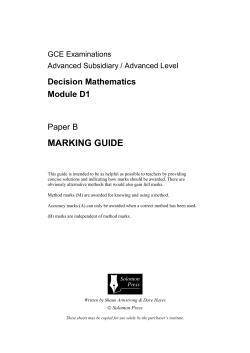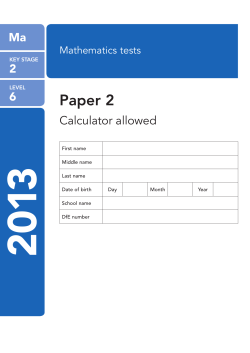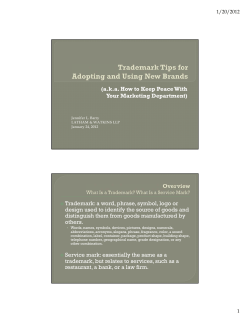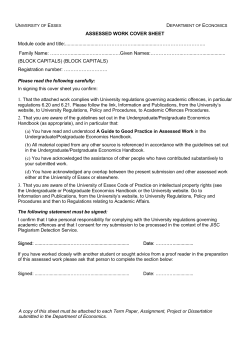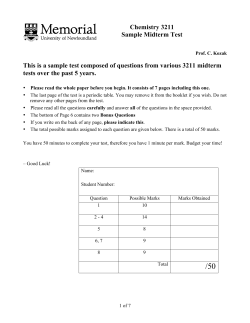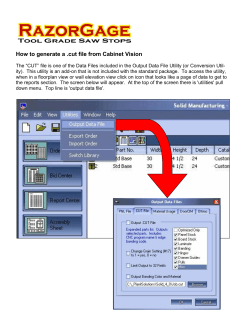
SAMPLE UNIT H860 Component 1
SAMPLE OCR Level 3 Certificate in Mathematics for Engineering UNIT H860 Component 1 Sample Paper Time: 2 hours Candidates answer on the question paper. Candidate Name Centre Number Candidate Number INSTRUCTIONS TO CANDIDATES • • • • Write your Name, Centre Number and Candidate Number in the spaces provided on the answer booklet. Answer all the questions. Give non-exact numerical answers correct to 3 significant figures, unless a different degree of accuracy is specified in the question or is clearly appropriate. Write your answers in black ink. INFORMATION FOR CANDIDATES • • • • • The number of marks is given in brackets [ ] at the end of each question or part question. The total number of marks for this paper is 60 The use of calculators is allowed for this paper Include all working out where used You are reminded of the need for clear presentation in your answers. ADVICE TO CANDIDATES • Read each question carefully and make sure you know what you have to do before starting your answer. This document consists of 5 printed pages. 1. An engineer starts working on a computer model of a football stadium which is in the shape of a perfect circle. a) In her program, she entered the radius as 5 and the co-ordinates of the centre as (6 , 3). Show that the equation of the circle she obtains is x 2 + y 2 -12 x - 6 y + 20 = 0 . [2] b) A straight cable needs to be installed between two poles P and Q on the circumference of the stadium. If the cable is represented by the straight line y = x + 4 in the computer model, show that the points P and Q will satisfy the equation x2 - 5x + 6 = 0 . [2] c) Factorise this equation in x and hence find the positions of the two poles P and Q. [2] 2. An engineer monitors the voltage across the output terminals of an electrical circuit for three seconds and at one second intervals. The readings are recorded in the following table. Time t (s) Voltage V 0 0 1 5 2 0 3 −3 The output voltage is to be modeled using a cubic equation of this form. V = at3 + bt2 + ct + d a) Use the data in the table to determine the values of the constants a, b, c and d. [3] b) Use the model to determine the maximum voltage during the first two seconds. [3] c) Use the model to draw a graph of V against t for t = 0 to 4, identifying all salient points accurately. [2] 2 3. A small engineering firm produces bolts. Each bolt has a probability of 0.16 of having a fault. Alice picks 3 bolts at random from the production line. a) Find the probability that i) All 3 bolts are faulty. [1] ii) Exactly 1 of the 3 bolts is faulty [2] b) The probability that a particular product is found faulty after manufacture is 0.001. A random sample of 500 of these products is selected and tested. Use the Poisson distribution to determine the following probabilities. i) Exactly one item is found to be faulty. [1] ii) Three or more of the 500 products are found to be faulty. [2] 4. The displacement, x mm, of an oscillating body, in an engine, at time t seconds is given by the formula: x = 10e-50t sin(200πt ) a) i) What is the frequency of oscillation? [1] ii) What is the period of the oscillation? [1] iii) Sketch a graph of x against t. [2] b) What is the maximum amplitude? [4] 3 5. A manufacturing company produces two products X and Y. Each product involves the use of three machines, A, B and C for certain amounts of time. The table below shows the time, in minutes, required on each machine for each product. Machine A Machine B Machine C Product X 5 2 6 Product Y 6 8 2 Each machine can be operated for a maximum number of hours per week as follows: Machine A: 30 hours; Machine B: 32 hours; Machine C: 30 hours. The unit profit obtained by selling product X is £20 and the unit profit obtained by selling product Y is £10. The company needs to determine the numbers of each product to manufacture each week to maximize its profit. a) Taking x to be the number of the product X produced each week, and y to be the number of the product Y produced each week, formulate this problem as a linear program. [2] b) Draw a suitable graph showing the constraints imposed on the number of each product produced each week. [3] c) Clearly indicate the feasible area on the graph for all possible values of x and y. [2] d) Find the number of products to produce each week in order to maximize the profit. Express your answer using integer numbers only. [2] 6. An engineer, designs a new energy efficient motor. The motor’s cam is the area, bounded by y = 2 + x2 , the x axis, x = 1 and x = 2 . The coordinates of the centroid of the cam are x and y are given by: b xydx x = ∫ab ∫a ydx a) and 1 b 2 ∫a y dx y= 2 b ∫a ydx Sketch a graph of the bounded area. [1] b) Determine the values of x and y . [7] 4 7. When an engineer monitors an electronic circuit to ensure that it is functioning properly, he finds that the rate of change of voltage, V, with respect to time, t seconds, across the output terminals of the circuit involving a capacitor of C farads and a resister of R ohms is described by the differential equation: dV 1 = ( K − V ) , where K is a constant voltage. dt RC Show that V = K (1 − e−t/RC ) is a solution to this differential equation. a) [2] b) Rearrange the formula V = K (1 − e−t/RC ) to make t the subject. [2] If K= 50 volts, R = 50 000 ohms and C = 10-6 farads, determine the time needed for the output voltage to reach 25 volts. c) [2] 8. As part of safety testing toughened glass used in the construction of large office buildings, a body is projected from the top of a 100m high tower. It is projected upwards at an angle of 30° to the horizontal and with a velocity of u m/s. There are no forces acting on the body other than gravity. The body travels until it reaches the sheet of glass which is taken to be horizontal and level with the base of the tower. a) The vertical acceleration of the body is described by the equation: d2y = − g , where g is the acceleration due to gravity. dt 2 Prove, from first principles, that the height the body, y, above the pane of glass at time t is given by: y= −gt 2 + usin(30o )t +100 2 [3] b) If u = 20m/s show that the time at which the body reaches the glass is 5.65 s. [3] c) Show that the height y with respect to the horizontal distance traveled, x, is given by: y= 2 −g ⎛ x ⎞ + xtan30o +100 ⎜ ⎟ 2 ⎝ ucos30o ⎠ [3] Paper Total [60] 5 OXFORD CAMBRIDGE AND RSA EXAMINATIONS Level 3 Certificate in Mathematics for Engineering Component 1 Unit H860 Sample Mark Scheme The maximum mark for this paper is 60. Question 1a Mark Radius = 5 Centre = (6 , 3) The general equation of the circle is given by: (x− a)2 + (y – b)2 = r2 Where r is the radius and (a, b) is the centre Therefore: (x− 6)2 + (y – 4)2 = 52 M1 x2 + 36 − 12x + y2 + 9 – 6y = 25 x2 + y2 − 12x – 6y + 45 – 25 = 0 A1 x2 + y2 − 12x – 6y + 20 = 0 2 1b Q P PQ: y = x + 4 Substituting y = x + 4 in the circle equation we get: x2 + (x + 4)2 – 12x – 6(x + 4) + 20 =0 M1 x2 + x2 + 16 + 8x – 12x – 6x – 24 + 20 2x2 – 10x + 12 = 0 A1 Dividing by 2 throughout we get: x2 – 5x + 6 = 0 2 2 Question 1c Mark Equation: x2 – 5x + 6 = 0 x2 –3x – 2x + 6 = 0 x(x – 3) – 2(x – 3) = 0 (x – 3) (x – 2) = 0 M1 x = 3 or x = 2 therefore y = x + 4 Therefore the co-ordinates for P and Q are (3 , 7 ) and (2 , 6) A1 2 Question 1 AC5.1/AC1.1 (4), AC4.2/AC10.1 (2) (6 marks) 2a 2b Since V = when t = 0, d = 0 B1 Since V = 0 at t = 0 and t = 2 , V=t(t − 2)(At+ B) where A and B are constant Or forming 3 simultaneous equations and finding one coefficient V =5 when t=1: (At + B)= −1 V = −3 when t = 3: (3t + b)= −3 Solving gives A = 2 and B = −7 Expanding t(t − 2)(2t − 7) = V = 2t3 − 11t2 + 14t : a = 2, b = −11, c = 14, d = 0 M1 dV dV = 6t 2 - 22t +14 and use of =0 dt dt M1 22 ± 484 - 4 × 6 × 14 dV = 0 when t = = 0.81954 and 2.847127 2×6 dt M1 Maximum occurs at 0.81954 giving V = 5.186 or 5.19 2c Suitable graph passing through points given in the table plus other salient points when t = 3.5, t = 4 and at the turning points. Shape correct All salient points indicated A1 3 A1 3 M1 A1 2 Question 2 AC4.2 (3), AC6.1(3), AC4.1(2) (8 marks) 3a i (a) (0.16)cubed = 0.004096 (accept 0.004 or better) 3 B1 Question 3a ii Mark 0.16 x (0.84) squared x 6 M1 =0.677 A1 If 0 scored, allow sc 1 for answer omitting '6' - 0.113 3b i 2 Use Poisson distribution p = ( x = r) p = 0.001, = e-u μ r r! n = 500, μ = np = 0.5 P (x =1) = e -0.5 (0.5) = 0.303(265) 1 3b ii e −0.5 (0.5) = 0.075816 2 2 P (x = 2) = M1 P (x ≥ 3) = 1 – ( P (x = 0) + P ( x = 1) + P ( x = 2) = 1 – 0.985612 = 0.0143(88) 2 Question 3 AC8.3(6) (6 marks) 4ai x = 10 e -50t sin (200 π t) f = 100 Hz 1 4 a ii T= 4 a iii 1 = 10 ms 100 1 M1 A1 Damped oscillating curve Approx correct indication of scale on x axis. 10 20 2 4 Question 4b Mark x = 10 e −50t sin (200 π t) dx = 10 e −50t 200 π cos (200 π t) dt −500 e −50t sin (200 π t) *M1 A1 = 10 e −50t (200 π cos (200 π t ) – 50 sin (200 π t)) = 0 when 200 π cos (200 π t) = 50 sin (200 π t) M1dep* 200 π = 50 tan (200 π t) 4 π = tan (200 π t) t= tan -1 4π = 2.37ms 200π A1 4 Question 4 AC2.2(4), AC3.2(4) (8 marks) 5 5a Maximise 20x + 10y, subject to: 5x + 6y ≤ 1800 2x + 8y ≤ 1920 6x + 2y ≤ 1800 One correct inequality Other two correct ( x ≥ 0, y ≥ 0) B1 B1 2 5b For constraint 1: (x = 0, y = 300); (x = 360, y = 0) For constraint 2: (x = 0, y = 240); (x = 960, y = 0) For constraint 3: (x = 0, y = 900); (x = 300, y = 0) B1 B1 B1 3 d) Objective function 20x + 10y maximum at the intersect of constraints 1 & 3 5x + 6y = 1800 6x + 2y =1800 Solutions given by x = 277 y = 69 3 Objective function c) Feasible Area 2 5c At least 2 constraints correctly shaded Other constraints correctly shaded 5d Correct point identified for maximizing profit (indicated or clear from working) Correct values for x and y. B1 B1 2 M1 A1 2 Question 5 AC7.4(9) (9 marks) 6 6a y y = 2 + x2 6 3 2 x 1 6b 2 ∫ y dx = ∫ 2 + x² dx = 2x + x3 +c 3 ∫ y² = ∫ 4 + 4x² + x4 dx = 4x + 4 x3 x5 + +c 3 5 ∫ xy dx = ∫ 2x + x³ dx = x 2 + x4 + c 4 1 B1 B1 B1 Condone missing ‘c’ for these B1 marks. 2 ∫ ydx = 1 ⎡ ⎢2x + ⎣⎢ = 2 2 ∫ y dx = 1 = 2 ∫ xydx = 1 2 8⎞ ⎛ 1 ⎞ 13 x3 ⎤ ⎛ ⎥ = 4+ ⎟-⎜2+ ⎟ = 3 ⎦⎥1 ⎜⎝ 3⎠ ⎝ 3⎠ 3 13 3 ⎡ 4 x3 ⎢4x + 3 ⎢⎣ 2 4 1⎞ x5 ⎤ ⎛ 32 32 ⎞ ⎛ + ⎥ =⎜8 + + ⎟ - ⎜ 4 + + ⎟ 5 ⎥⎦1 ⎝ 3 5 ⎠ ⎝ 3 5⎠ 293 15 ⎡ 2 ⎢x ⎢⎣ 2 ⎛ 1 ⎞ 27 x4 ⎤ + ⎥ = ( 4 + 4 ) - ⎜1+ ⎟ = 4 ⎥⎦1 4⎠ 4 ⎝ For correct use of limits in any one of these three integrals For correct evaluation of one of these integrals x= 27 3 = 1.55769 4 13 y= 1 293 3 = 2.53846 2 15 13 Accept 1.55 or 1.56 and 2.53 or 2.54 if rounded or truncated Question 6 AC6.3 (1), AC6.4(7) (8 marks) 7 B1 B1 A1,A1 CAO 7 7a - t v = k (1- e RC ) ------ (1) dv 1 = (K – v) -------- (2) dt RC substitute (1) in (2) dv 1 = (K – K (1 – e dt RC K e = RC - t RC - t RC )) B1 …………(3) B1 Convincing conclusion to given result t Differentiate (1) dv K = e dt RC - RC = result (3) 2 7b V = K (1 - e - t RC ) t RC V = (1 - e ) K t V e RC = 1 K t V = ln(1 - ) RC K V t = - RCln(1 - ) K - M1 A1 2 7c ⎛ 25 ⎞ t = -5×104 ×10-6 ln ⎜1- ⎟ ⎝ 50 ⎠ M1 = 0.05 ln ½ = 34.6(47) A1 2 Question 7 AC2.3/AC6.1 (2), AC 2.2/9.2 (2), AC 9.2 (2) (6 marks) 8 8a d2y = -g dt 2 dy = − gt + c dt *M1 dy = usin30o when t = 0, therefore c = usin30o dt dy = - gt + usin30o dt - gt 2 + usin(30o )t + k y= 2 A1 M1dep* y = 100 when t = 0, therefore k = 100 y= - gt 2 + usin(30o )t +100 2 3 8b − gt 2 + 10t + 100 = 0 2 t= M1 − 10 ± 100 + 200 g −g − 10 ± 100 + 1960 − 9.8 answer must be – ve root 8c let g = 9.8 = − 10 ± 45.387 − 9.8 − 10 − 45.387 = 5.65 − 9.8 A1 3 M1 x = u cos 30° t t= A1 -x ucos30o substitute in 1a y= 2 -g ⎛ x x ⎞ ⎛ ⎞ o ⎜ o ⎟ +u⎜ o ⎟ sin30 +100 2 ⎝ ucos30 ⎠ ⎝ ucos30 ⎠ For convincing algebra to achieve given result M1 A1 2 y= -g ⎛ x ⎞ o ⎜ o ⎟ + xtan30 +100 2 ⎝ ucos30 ⎠ 3 Question 8 AC1.2 (3), AC2.3(3), AC3.1/AC9.2(3) (9 marks) 9 LO1 AC Æ 1.1 1.2 LO2 2.1 2.2 LO3 2.3 3.1 3.2 Lo4 4.1 4.2 LO5 5.1 5.2 LO6 5.3 6.1 6.2 6.3 LO7 6.4 7.1 7.2 7.3 LO8 7.4 7.5 8.1 8.2 LO9 8.3 9.1 9.2 LO10 9.3 10.1 Total marks for question Question X X 1 (a) 1 (b) X X 1 (c) 2 (a) X 2 (b) X 2 (c) X X 3 (a) 3 (b) X 4 (a) X 4 (b) X X X X 5 (a) 5 (b) 5 (c) 5 (d) X 6 (a) X 6 (b) X 7 (a) X X 7 (b) 7 (c) X 8 (a) X 8 (b) 8 (c) Total marks for AC 0 3 0 4 5 X 3 4 2 5 4 0 0 3 0 10 1 7 0 0 0 9 0 0 0 6 0 4 0 0 2 2 2 3 3 2 3 3 4 4 2 3 2 2 1 7 2 2 2 3 3 3 60
© Copyright 2025








